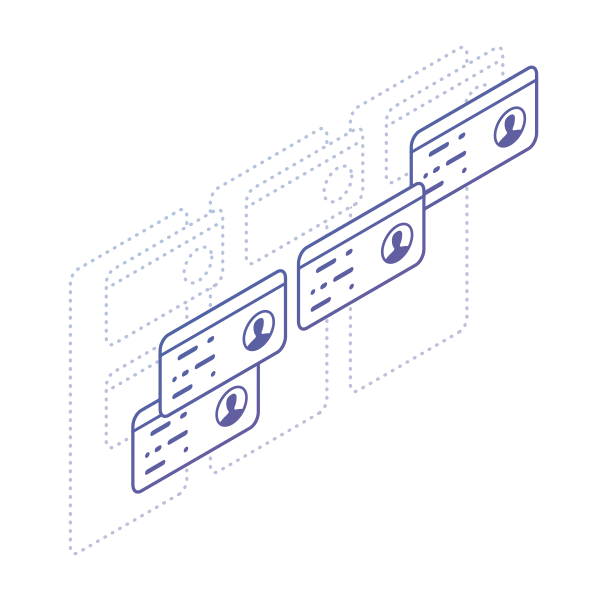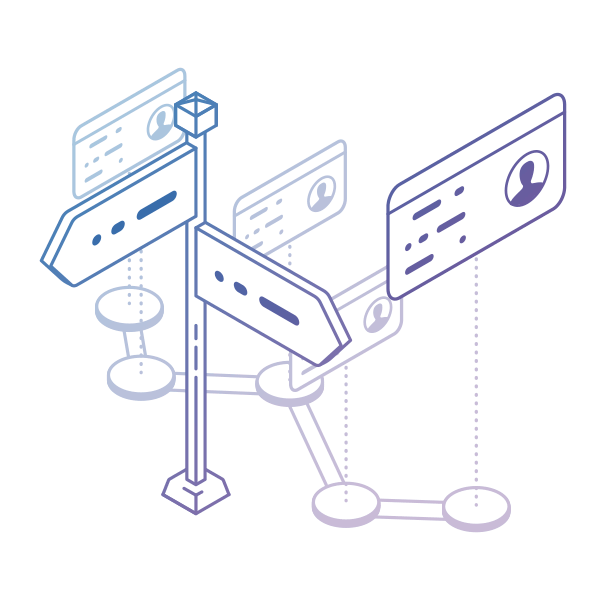What Are Kanban Swimlanes?
Kanban swimlanes are horizontal lines that split a kanban board into sections. Teams usually use them to visually separate different work types on the same board and organize homogenous tasks together.
What Can You Use Kanban Swimlanes for?
A simple example of a kanban swimlane would be the separation of different product types (“Hardware” and “Services”) of your procurement team. In this case, separate swimlanes give you a better overview of the workload per product type and help you achieve a better flow.
 Kanban board with two Swimlanes
Kanban board with two Swimlanes
When talking about flow, we should also mention limiting work-in-progress (WIP). As you are probably familiar with, your workflow's different stages should have limits so your team members focus on finishing rather than constantly starting new work.
The same applies to the kanban swimlanes. Taking the procurement example from above, you should set separate WIP limits for the Hardware and Service lanes that conform to the overall limit of the “In Progress” work stage on the kanban board.
Generally speaking, kanban swimlanes are used to separate different types of work. How you should apply them depends on the specifics of your workflow. However, there are some major types of lanes that you should be familiar with, so keep reading below.
Different Types of Kanban Swimlanes
The most common types of swimlanes on a kanban board are:
– Individuals/Teams/Clients
– Repetitive tasks
– Classes of Service (Expedite, Fixed Delivery Date, Standard, Intangible)
– Company-level lanes
– Discarded Options
Let’s briefly go over each one of them.
Individuals/Teams/Clients
You can create dedicated kanban swimlanes to visualize the work of different teams or individuals. Here you see the three units of “Application & Assembly” (Fly Engine Subsidiary, Flow Air, and Wings LTD Subsidiary) have dedicated swimlanes. Although they all share the same workflow, this gives a better overview of which unit tasks are piling up, or additional capacity is needed.
 Kanban board with multiple Swimlanes
Kanban board with multiple Swimlanes
Furthermore, you can use kanban swimlanes to separate work for different clients and better visualize what you are preparing for them. This scenario is not very common, but it is very effective for long-term clients.
For example, let's say you are a project delivery firm for engineering and construction, working with different clients on their new corporate headquarters or a new production facility. Separating the different projects' tasks in dedicated swimlanes on your team-boards will make the management of such large, long-term projects much easier. This way, you will ensure the project status and workload are easy to monitor and track.
Repetitive Tasks
Sometimes, teams have many recurring tasks. For example, an IT operations team might have maintenance tasks that require the regular backup of important business files within a network system.
Those are work items that provide the organization with higher security. Due to their repetitive nature, it’s a good practice to use kanban swimlanes to visualize and separate them from the rest. This way, you will be able to further de-clutter your kanban board, especially if you have a larger volume of both one-time and recurring tasks.
 Kanban board with a "Recurring Tasks" Swimlane
Kanban board with a "Recurring Tasks" Swimlane
Classes of Service
Visualizing different classes of service is one of the most widely used options for kanban swimlanes. These lanes provide teams with a solution to prioritize tasks effectively and reduce risk.
As you can imagine, different types of work items will not have the same type of “urgency” attached to them. That’s why there are 4 classes of service for priority management in Kanban, which you can separate and visualize with the help of kanban swimlanes. We are listing them below.
- Expedite
- Fixed Delivery Date
- Standard
- Intangible
10 Years Kanban Experience In 1 Free Book.
Project Manager's Guide to Kanban
Expedite
This class of service is reserved for work items that have the highest priority, which means that they require your team’s full devotion. You can create a separate Expedite swimlane on your kanban board for that class of service and process items through it that are critical, have high-risk and might be blocking your other tasks from moving forward.
 Kanban board with an Expedite Lane
Kanban board with an Expedite Lane
Fixed Delivery Date
A fixed delivery date is reserved for work items that need to be done by a certain point in time. You can use a dedicated kanban swimlane to visualize and separate items that might accumulate a high cost of delay (CoD) if not finished within a given timeframe.

Standard
The standard class of service represents the normal activities in your workflow that don’t come with much risk or cost of delay attached to them. That’s why, in case the work items in your project are not homogenous, a good practice is to use a kanban swimlane to separate the standard tasks from those with higher priority.
Intangible
The last class of service in Kanban is Intangible. It is reserved for the tasks that are non-urgent in the given moment and thus bear the lowest risk and cost of delay. As you’ve probably guessed, you can visualize and separate those work items from the rest, too, with the help of a dedicated kanban swimlane.
Learn more about Kanban classes of service.
Discarded Options
When working on projects, teams often come up with many different ideas on how to approach the work's execution and how to develop specific things. However, many of those ideas never come to pass and are abandoned during the refinement process. A problem arises when those options are discarded and never considered again because it might turn out that their alternatives are not the better choice.
In Kanban, a good practice is to keep discarded options for a while in a dedicated swimlane before completely rejecting them. This will give you greater flexibility to reflect on your decision to choose a certain option over another and determine whether something has been properly discarded.
Company-Level Lanes
Apart from separating and visualizing different types of work on the team-level, there are also company-level kanban swimlanes that you can apply. This is part of Portfolio Kanban and works best when you are scaling Kanban across the entire organization.
 Portfolio Kanban board
Portfolio Kanban board
For example, you can use a dedicated lane to visualize your wider company objectives on a Portfolio Kanban board. After that, you can break down those bigger strategic objectives into smaller key results that are visualized and separated with their own kanban swimlanes. Those key results can be further broken down into epics/projects allocated to the respective teams and live both on the Master Kanban board and the separate team boards within the company.
Kanban Swimlanes at Businessmap
Hopefully, by now, you have a good grasp of kanban swimlanes and how they can be used. While they are a great solution for better work organization and prioritization, at Businessmap, we always follow the mantra of “continuous improvement,” which we have now applied to our software's swimlanes, too.
So far, the standard approach has been to use one kanban board per workflow and apply different lanes within it. However, when we identify more than one unique flow of work items in our teams, our best practice is to use Multiple Workflows on one kanban board and then apply swimlanes within them. The concept is simple. For example, a Customer Success team can use two workflows on their kanban board – Requests from Existing Clients and Internal Activities.
 Kanban board with multiple Workflows and several Swimlanes
Kanban board with multiple Workflows and several Swimlanes
In the former – Existing Clients’ Requests, they can have different kanban swimlanes to separate tickets from hot customers (highest priority), small and medium-sized businesses, enterprises, customers interested in a specific integration, etc. The latter workflow – Internal activities, can serve as a place where they visualize tasks, unrelated to clients’ work, that they have to do internally for the company.
This Kanban board example will allow the team to organize their activities better, keep everything in one place, further reduce context switching, and increase their productivity levels.
Businessmap is the most flexible software
to align work with company goals
In Summary
Kanban swimlanes represent lines that divide a board horizontally. They have various use cases, with the main types summarized below. You can create swimlanes for:
- Individuals/Teams/Clients
- Repetitive tasks
- Company-Level Lanes
- Classes of Service (Expedite, Fixed Delivery Date, Standard, Intangible)
- Discarded Options





 Kanban board with two Swimlanes
Kanban board with two Swimlanes Kanban board with multiple Swimlanes
Kanban board with multiple Swimlanes Kanban board with a "Recurring Tasks" Swimlane
Kanban board with a "Recurring Tasks" Swimlane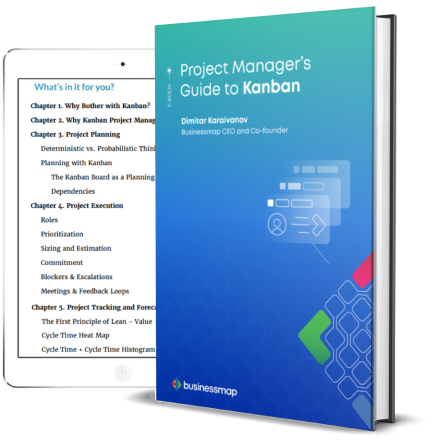
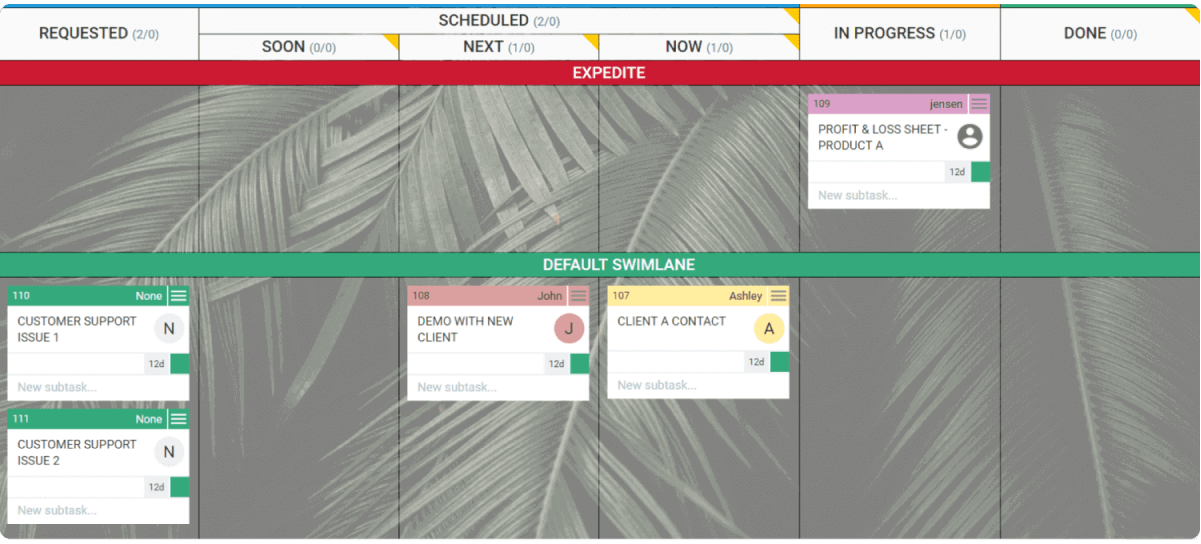 Kanban board with an Expedite Lane
Kanban board with an Expedite Lane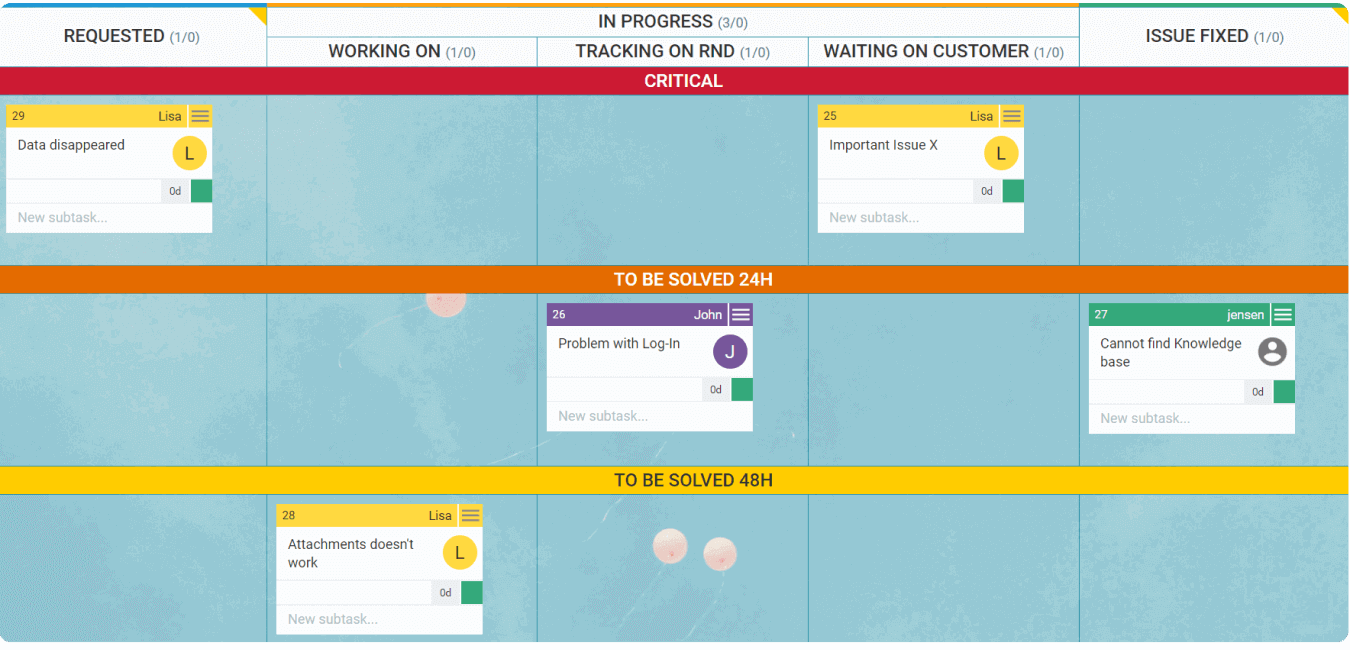
 Portfolio Kanban board
Portfolio Kanban board Kanban board with multiple Workflows and several Swimlanes
Kanban board with multiple Workflows and several Swimlanes
